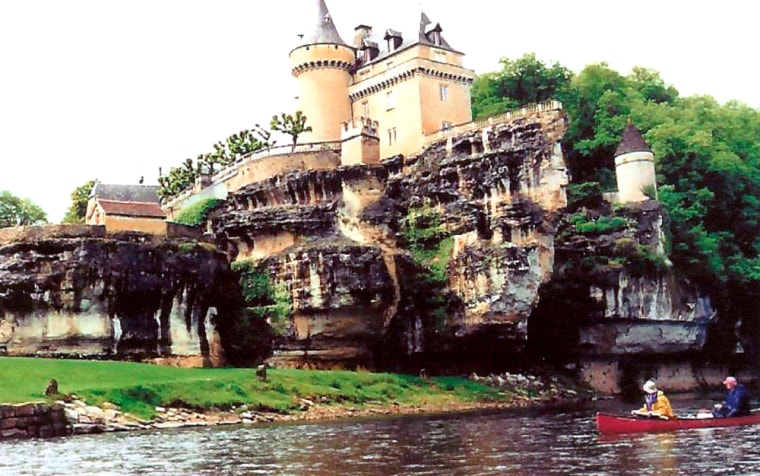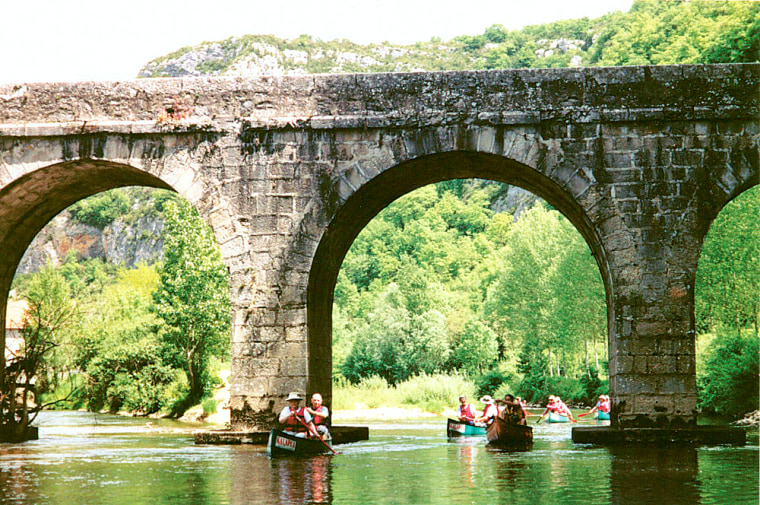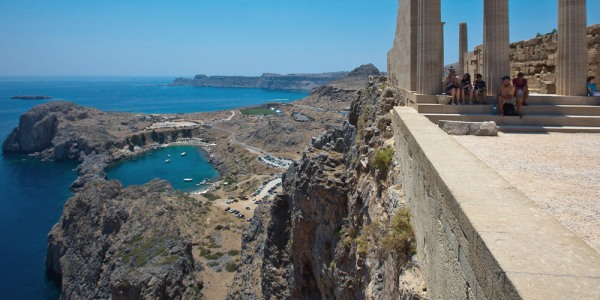So you’re an old pro at the sport. You can make your canoe skim through the rocks, safely run a waterfall, shoot the roughest rapids. But here’s one trick you’ve probably never tried. On a trip to southwest France, we morphed our canoes into time machines, and spanned 370 centuries in just 12 days, paddling inn-to-inn on four rivers.
We were in the Périgord, a region best known to Americans as the Dordogne, where the riverbanks have witnessed 37,000 years of human advancement. Because waterways have been key to life in this region since prehistoric times, there is no better way to tour the Dordogne. Each river has a very different story to tell, beginning with the Vézére, where Cro-Magnon man and his predecessors chose the towering limestone cliffs for their cave homes, bequeathing artifacts, sculptures, and amazingly well preserved cave art to modern-day archaeologists and tourists. Two-thirds of the 120 or so art-decorated prehistoric caves in the world are found right here.
The banks of the Lot and Dordogne Rivers provide a panoramic history of life and culture dating back to the Middle Ages. Imposing forts and chateaux, high atop the cliffs, protect beautifully preserved medieval villages that seem to climb, one house on top of another, up the sheer limestone walls that girdle the rivers. The sprightly Célé, winding through farmland and forest, reveals contemporary Périgord, the pastoral bread and wine basket, source of fine vintages and veggies, the world’s primary supplier of foie gras.
On our very first afternoon, we fell inevitably in love with this land of geese, ducks, cheese, truffles, walnuts, and superb wine. Our group of 12 gathered on the grassy riverbank at St. Leon sur Vézére with our leaders, Jim Walker and Carolyn Parker, from BattenKill Canoe in Arlington, Vermont. We were mesmerized by the rippling reflections of the ninth century church in the gentle waters of the Vézére and the shimmering of filmy willows that characterize this sleepy hamlet.
We soon settled into the leisurely pace of the Vézére as we paddled toward Les Eyzies de Tayac, where Cro-Magnon’s remains were discovered in the late 19th century. A mighty statue of Cro-Magnon man greeted us as we trudged from the riverbank to our hotel, soaked to the skin by an inescapable cloudburst. It is a short walk from the town center is the Grotte de Font-de-Gaume, home to a remarkable variety of cave paintings.

It is important to get there early. The dry interior of the cave helps to preserve the 80 bison and human figures, and excessive exposure to human breath can severely harm these paintings, requiring the authorities to restrict the number of visitors to just 200 per day.
A huge fortress and majestic chateau tower over Rocamadour, our next stop. They were designed centuries ago to police the river and protect the vertical cliff-side village far below. Built into the bluff midway between the castle and the town is the Sanctuary of Notre Dame, where the Black Virgin still wears her jeweled silver crown in the Chapelle de la Vierge Noire, a key pilgrimage destination during the 11th and 12th centuries. It was here that repentant sinners were forced to climb on bleeding knees up the 216 steps of the Via Sancta to reach the seven churches, basilicas, and chapels adjoining Notre Dame. Today ascenseurs (elevators) are there to carry us up, even if we have sinned.
Slideshow 23 photos
A European tour
The next evening, a bit tired and stiff after eight hours of effort on our longest river day, we finally beached at Marcilhac, a tiny farming hamlet of such charm it made every stroke worthwhile. With a population of 156, it is actually one of the larger villages in the Célé Valley. Its original Benedictine abbey was pillaged in the Hundred Years War, rebuilt in Gothic style, and then ravaged by Protestants in the Wars of Religion. A walk through the badly battered Romanesque courtyard graphically illustrates the turmoil that racked this region in post-Medieval times.
Our misgivings as we lined our canoes above the old 12-foot-high milldam the next morning quickly faded as we concentrated on a strategy for negotiating the sluice. Not a single canoe dumped in the swirling waters at the base, an achievement that allowed us to graduate to master canoeists—at least in our own minds.
Later in the day, we feasted on cabecou (sharp local goat cheese) and foie gras, spread on peasant bread with freshly picked tomatoes. Our dining table was a canoe turned upside down on the riverbank and covered with a festive red-and-white tablecloth.
Next we overnighted in Cabrerets. A two-mile uphill walk along a narrow wooded path brought us to Grotte du Pech-Merle, one of the world’s finest prehistoric painted caves. Its entrance hidden for centuries during the Ice Age, the Grotte (cave) now opens to the Chapel of the Mammoths, an extraordinary collection of animal paintings, followed by the Ceiling of Hieroglyphics, which mixes undecipherable symbols with human and animal art. The color and outlines of the paintings here were the best preserved that we saw on the trip. These prehistoric artists were the world’s first to use the airbrush, blowing paint through bone pipes to outline their creations.
Back in our canoes, we reached the junction of the Célé and Lot Rivers by afternoon. We were nearing our goal, St.-Cirq Lapopie. Set spectacularly on a sheer cliff above the river and enclosed in crumbling medieval ramparts, this hamlet of fewer than 200 residents is considered by many to be the most photogenic site in all of France. Narrow streets and lanes twist up and down the ubiquitous hills of the village between gray and tan stone homes and shops dating back to the Middle Ages. A spectacular location, but challenging to reach by foot, it is perched 350 feet above the river.
We pulled ashore at Bouzies, the closest take-out to St. Cirq, then hiked the ancient towpath alongside the Lot River, across two farms, and up a torturous narrow and rocky path. We were puffing heavily when we finally reached the top, only to become even more breathless at the grandeur of the vista, mile upon mile of verdant farmland and forest.
Our next destination was Beynac. At the confluence of the Dordogne and Ceou Rivers, it is the ideal spot to study the Hundred Years War and the hostility between the French and the English as they battled for control of the region. The ferocious dukes of Beynac were based in a huge castle above the town. Standing on the parapet, it is easy to see how well the fort controlled the river, which means around the village below. Rocks were heaved down from huge catapults, still intact, to smash enemy vessels.
We spent the last two days of our trip in the vicinity of Beynac. At our group’s final dinner, we bade farewell to the river flowing majestically below our window seats in the hotel’s outer dining room. It was our last hurrah and our last foie gras. Mellow with wine, we all agreed that our “time machines” had added an unanticipated dimension to the canoeing that many of us had done for years, both in the United States and abroad. It was perhaps the most diverse, educational, and enjoyable journey that any of us had ever taken.
If you go...
Information on Périgord is available at the French Tourist Offices in New York City (212) 838-7800 and Beverly Hills (310) 271-2693. The region can be accessed through flights to Bordeaux or Paris. From Charles de Gaulle Airport, go to the Austerlitz Rail Station for a train to Brive, a four-hour trip. BattenKill Canoe runs guided trips to the Dordogne in May, June, September, and October. They can be reached at www.battenkill.com or (800) 421-5268. E-mail: trip@battenkill.com.
Canoe & Kayak Magazine is the number one paddlesports resource, with a wealth of information about canoeing and kayaking destinations, gear, and techniques.
Charles Jacobs is the former editor-in-chief of Travel World Magazine. He can be reached at jac391@aol.com.

